Project Management Report: Risk Management, Closure & Methodologies
VerifiedAdded on 2023/06/11
|15
|3357
|379
Report
AI Summary
This report provides a comprehensive analysis of key aspects of project management, including risk management with a detailed risk register, the importance of correctly managing project closure, and a comparison of different project management methodologies such as Waterfall, Agile, and PRINCE2. The risk management section emphasizes identifying, assessing, and mitigating potential risks, with a sample risk register provided. The discussion on project closure highlights its importance in confirming objectives, improving future events, and tying up loose ends. The analysis of methodologies compares their strengths and weaknesses, offering recommendations for the most suitable approach. The report also includes a project initiation document, stakeholder analysis, Gantt chart, and a discussion on the importance of WBS and critical path analysis.
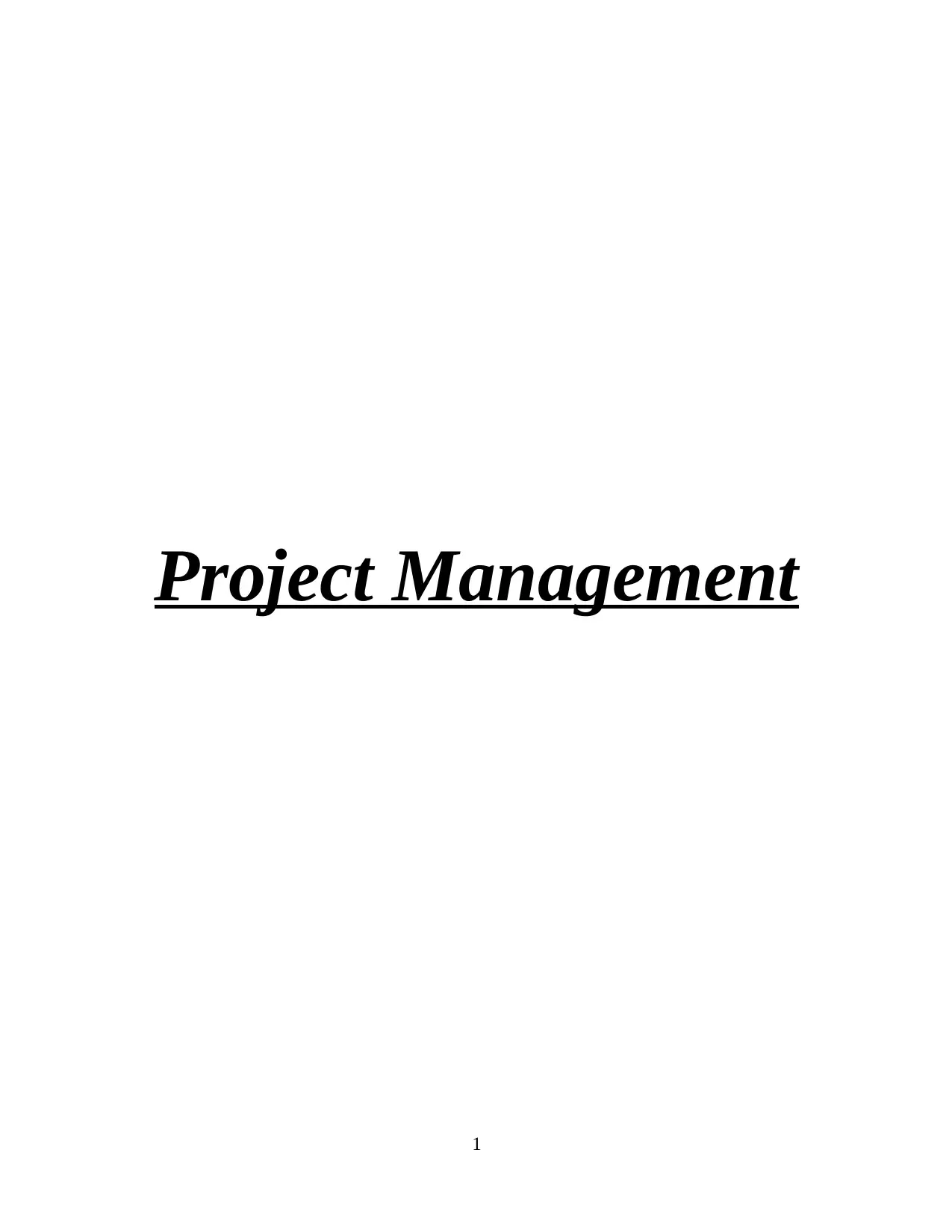
Project Management
1
1
Paraphrase This Document
Need a fresh take? Get an instant paraphrase of this document with our AI Paraphraser

Table of Contents
Part A ..............................................................................................................................................3
Risk management including risk register table .....................................................................3
Part 2................................................................................................................................................5
Importance of correctly managed Project Closure.................................................................5
Part 3 ...............................................................................................................................................7
Discussing methodologies of project management ...............................................................7
References ....................................................................................................................................10
Appendix ......................................................................................................................................11
Project Initiation Document...........................................................................................................11
Stakeholder Analysis of the project......................................................................................11
Gantt chart............................................................................................................................12
Importance of WBS in managing the tasks on a project...............................................................13
Importance of critical path analysis...............................................................................................13
2
Part A ..............................................................................................................................................3
Risk management including risk register table .....................................................................3
Part 2................................................................................................................................................5
Importance of correctly managed Project Closure.................................................................5
Part 3 ...............................................................................................................................................7
Discussing methodologies of project management ...............................................................7
References ....................................................................................................................................10
Appendix ......................................................................................................................................11
Project Initiation Document...........................................................................................................11
Stakeholder Analysis of the project......................................................................................11
Gantt chart............................................................................................................................12
Importance of WBS in managing the tasks on a project...............................................................13
Importance of critical path analysis...............................................................................................13
2

Part A
Risk management including risk register table
Risk management is the process of identifying risks before initiating a project in order to
prepare for uncertainties and develop contingency plans for the same. The function of risk
management is crucial in the project management as it deals with defining risks and ascertaining
their probability and take preventive measures in order to mitigate the threats and their impacts.
The importance of risk management register is highly significant in determining the impacts and
scope of a particular risk associated with the project. The relevance of risk register is very crucial
in planning a project and what are the actions that needed to be taken to reduce such risks
possibilities. Moreover, this risk register is used for reference purpose during the whole process
of planning and executing a project as well (Hair and Sarstedt, 2021). For instance without
proper maintenance of risk register the risk of uncertain weather cannot be accessed and with
risk maintenance register, it will be planned how to make arrangements in backup space.
Maintaining risk register helps in proper allocation of funds and all the risks are accessed to be
covered through maintaining a separate budget for addressing risk factors. It helps in integrating
efforts and provides assistance in improving the overall execution of the project. Risk register
access and address all the risk factors and state what has to be done in order to cope with threats
of various risks. Following is the risk register for the project of sporting event.
Risks description Likelihood Impacts Severity Owner Mitigating action
Lack of resources Medium Low success of
the organised
event
Medium Project
manager
Ensuring optimal
use of funds with
strategic planning
and minimising
wastage.
Financial risks High Various issues in
sponsoring event
and lack of
fame , low
success of event.
Overall impact
High Principal Ensuring
unnecessary
expenses and
developing
contingency plans
for mitigating
3
Risk management including risk register table
Risk management is the process of identifying risks before initiating a project in order to
prepare for uncertainties and develop contingency plans for the same. The function of risk
management is crucial in the project management as it deals with defining risks and ascertaining
their probability and take preventive measures in order to mitigate the threats and their impacts.
The importance of risk management register is highly significant in determining the impacts and
scope of a particular risk associated with the project. The relevance of risk register is very crucial
in planning a project and what are the actions that needed to be taken to reduce such risks
possibilities. Moreover, this risk register is used for reference purpose during the whole process
of planning and executing a project as well (Hair and Sarstedt, 2021). For instance without
proper maintenance of risk register the risk of uncertain weather cannot be accessed and with
risk maintenance register, it will be planned how to make arrangements in backup space.
Maintaining risk register helps in proper allocation of funds and all the risks are accessed to be
covered through maintaining a separate budget for addressing risk factors. It helps in integrating
efforts and provides assistance in improving the overall execution of the project. Risk register
access and address all the risk factors and state what has to be done in order to cope with threats
of various risks. Following is the risk register for the project of sporting event.
Risks description Likelihood Impacts Severity Owner Mitigating action
Lack of resources Medium Low success of
the organised
event
Medium Project
manager
Ensuring optimal
use of funds with
strategic planning
and minimising
wastage.
Financial risks High Various issues in
sponsoring event
and lack of
fame , low
success of event.
Overall impact
High Principal Ensuring
unnecessary
expenses and
developing
contingency plans
for mitigating
3
⊘ This is a preview!⊘
Do you want full access?
Subscribe today to unlock all pages.

Trusted by 1+ million students worldwide

on capital and
reserves of
university.
financial risks.
Severe Injuries of
players
Medium Loss of players
in game and
compromising
with well-being
of individuals.
High Coach Proper equipments
for safety of
players.
Uncertainty of
weather
Low Delay in event Medium Project
manager
Developing
contingency plan
for covering costs
of event.
Postponing of
event
Low Loss of funds
and opportunity
cost
High Project
manager
Effective planning
and preparing for
covering costs in
case of postpone.
Medical costs due
to injuries
High Loss of funds High Coach Making
arrangements and
prior agreements
with nurses and
doctors at the
event.
Insufficient
arrangements
Medium Less fame, low
success
Low Project
assistant
Strategic planning
with delegation of
work.
Loss of reputation
due to low
performances of
players
Medium Declining image
of the university
and future impact
on events
Medium Principal Ensuring high and
effective coaching
and practise before
the event.
4
reserves of
university.
financial risks.
Severe Injuries of
players
Medium Loss of players
in game and
compromising
with well-being
of individuals.
High Coach Proper equipments
for safety of
players.
Uncertainty of
weather
Low Delay in event Medium Project
manager
Developing
contingency plan
for covering costs
of event.
Postponing of
event
Low Loss of funds
and opportunity
cost
High Project
manager
Effective planning
and preparing for
covering costs in
case of postpone.
Medical costs due
to injuries
High Loss of funds High Coach Making
arrangements and
prior agreements
with nurses and
doctors at the
event.
Insufficient
arrangements
Medium Less fame, low
success
Low Project
assistant
Strategic planning
with delegation of
work.
Loss of reputation
due to low
performances of
players
Medium Declining image
of the university
and future impact
on events
Medium Principal Ensuring high and
effective coaching
and practise before
the event.
4
Paraphrase This Document
Need a fresh take? Get an instant paraphrase of this document with our AI Paraphraser
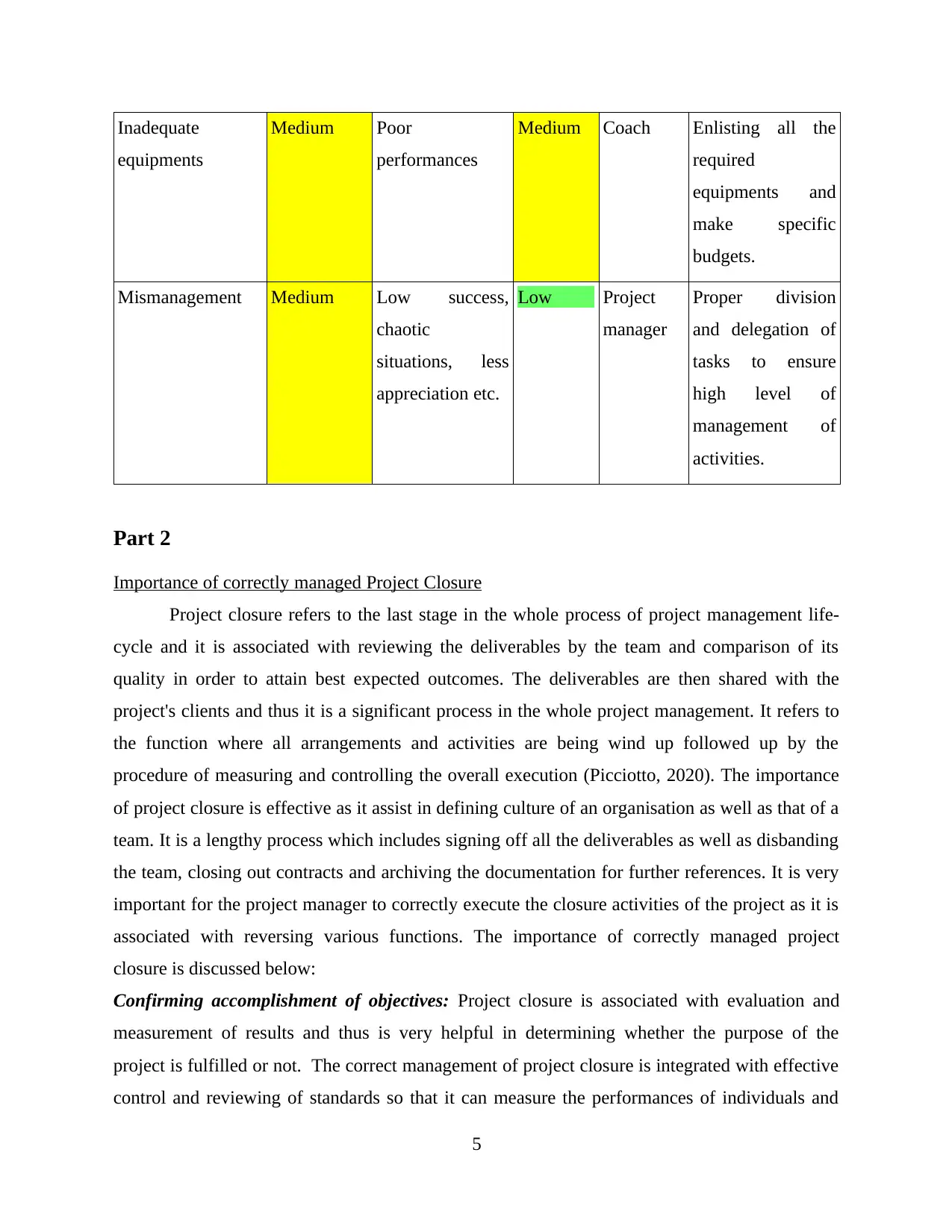
Inadequate
equipments
Medium Poor
performances
Medium Coach Enlisting all the
required
equipments and
make specific
budgets.
Mismanagement Medium Low success,
chaotic
situations, less
appreciation etc.
Low Project
manager
Proper division
and delegation of
tasks to ensure
high level of
management of
activities.
Part 2
Importance of correctly managed Project Closure
Project closure refers to the last stage in the whole process of project management life-
cycle and it is associated with reviewing the deliverables by the team and comparison of its
quality in order to attain best expected outcomes. The deliverables are then shared with the
project's clients and thus it is a significant process in the whole project management. It refers to
the function where all arrangements and activities are being wind up followed up by the
procedure of measuring and controlling the overall execution (Picciotto, 2020). The importance
of project closure is effective as it assist in defining culture of an organisation as well as that of a
team. It is a lengthy process which includes signing off all the deliverables as well as disbanding
the team, closing out contracts and archiving the documentation for further references. It is very
important for the project manager to correctly execute the closure activities of the project as it is
associated with reversing various functions. The importance of correctly managed project
closure is discussed below:
Confirming accomplishment of objectives: Project closure is associated with evaluation and
measurement of results and thus is very helpful in determining whether the purpose of the
project is fulfilled or not. The correct management of project closure is integrated with effective
control and reviewing of standards so that it can measure the performances of individuals and
5
equipments
Medium Poor
performances
Medium Coach Enlisting all the
required
equipments and
make specific
budgets.
Mismanagement Medium Low success,
chaotic
situations, less
appreciation etc.
Low Project
manager
Proper division
and delegation of
tasks to ensure
high level of
management of
activities.
Part 2
Importance of correctly managed Project Closure
Project closure refers to the last stage in the whole process of project management life-
cycle and it is associated with reviewing the deliverables by the team and comparison of its
quality in order to attain best expected outcomes. The deliverables are then shared with the
project's clients and thus it is a significant process in the whole project management. It refers to
the function where all arrangements and activities are being wind up followed up by the
procedure of measuring and controlling the overall execution (Picciotto, 2020). The importance
of project closure is effective as it assist in defining culture of an organisation as well as that of a
team. It is a lengthy process which includes signing off all the deliverables as well as disbanding
the team, closing out contracts and archiving the documentation for further references. It is very
important for the project manager to correctly execute the closure activities of the project as it is
associated with reversing various functions. The importance of correctly managed project
closure is discussed below:
Confirming accomplishment of objectives: Project closure is associated with evaluation and
measurement of results and thus is very helpful in determining whether the purpose of the
project is fulfilled or not. The correct management of project closure is integrated with effective
control and reviewing of standards so that it can measure the performances of individuals and
5

execution of various activities (Bjorvatn and Wald, 2018). It access whether the requirements of
clients is fulfilled or not and what are the outcomes of the project. A constructive strategy and
planning of project closure critically evaluate the scale of success of the project.
Helpful in improving future events: The constructive process of project management assist in
future events and facilitate in collecting references for future purpose. Unless the outcomes and
standards of a project is not determined, it is not possible to learn from mistakes and improve the
scope for future purposes (Ismail and Mansor, 2018). The project closure of sport events would
help in analysing the outcomes and implications after reflecting on the mistakes and thus it is
helpful for future references as on how to overcome the shortcomings of this project in future.
Properly managed project closure assist in evaluating mistakes happened and thus it becomes a
effective reference for future events.
Typing up loose ends: There are various important and significant tasks that are to be done when
closing a project to avoid chaotic situations. Making final payments, refunding the equipments
that are used in the sporting events, winding up the setup etc. are some project closure tasks
which has to be executed in efficient manner (Kerzner, 2022). A properly managed project
closure ensures that final tasks are accomplished with effectiveness. It is important for project
manager to make sure that all the final payments are done and it is also associated with
estimating the final expenses. Moreover, a properly managed project closure evaluate how much
money is spent extra above the determined budget.
Rewarding the teams: The significance of project closure is also highly crucial in relation with
giving rewards and constructive feedback to the individuals and teams responsible for successful
implementation of the project. It is important for providing teams with recognition and
appreciation in order to motivate them and prepare for the future events. A properly managed
project closure ensures that teams are rewarded as per their performance and contribution in the
execution of sporting events so that they feel valued and encouraged to perform even better in
next project.
Gaining better knowledge: A properly managed project closure helps in gaining better
knowledge about the whole event and thus it is very helpful in enhancing project management
skills of an individual (Obradović, Todorović and Bushuyev, 2018). Moreover, it helps in
acquiring better overview of the execution procedures and thus it helps in gaining enhanced
6
clients is fulfilled or not and what are the outcomes of the project. A constructive strategy and
planning of project closure critically evaluate the scale of success of the project.
Helpful in improving future events: The constructive process of project management assist in
future events and facilitate in collecting references for future purpose. Unless the outcomes and
standards of a project is not determined, it is not possible to learn from mistakes and improve the
scope for future purposes (Ismail and Mansor, 2018). The project closure of sport events would
help in analysing the outcomes and implications after reflecting on the mistakes and thus it is
helpful for future references as on how to overcome the shortcomings of this project in future.
Properly managed project closure assist in evaluating mistakes happened and thus it becomes a
effective reference for future events.
Typing up loose ends: There are various important and significant tasks that are to be done when
closing a project to avoid chaotic situations. Making final payments, refunding the equipments
that are used in the sporting events, winding up the setup etc. are some project closure tasks
which has to be executed in efficient manner (Kerzner, 2022). A properly managed project
closure ensures that final tasks are accomplished with effectiveness. It is important for project
manager to make sure that all the final payments are done and it is also associated with
estimating the final expenses. Moreover, a properly managed project closure evaluate how much
money is spent extra above the determined budget.
Rewarding the teams: The significance of project closure is also highly crucial in relation with
giving rewards and constructive feedback to the individuals and teams responsible for successful
implementation of the project. It is important for providing teams with recognition and
appreciation in order to motivate them and prepare for the future events. A properly managed
project closure ensures that teams are rewarded as per their performance and contribution in the
execution of sporting events so that they feel valued and encouraged to perform even better in
next project.
Gaining better knowledge: A properly managed project closure helps in gaining better
knowledge about the whole event and thus it is very helpful in enhancing project management
skills of an individual (Obradović, Todorović and Bushuyev, 2018). Moreover, it helps in
acquiring better overview of the execution procedures and thus it helps in gaining enhanced
6
⊘ This is a preview!⊘
Do you want full access?
Subscribe today to unlock all pages.

Trusted by 1+ million students worldwide
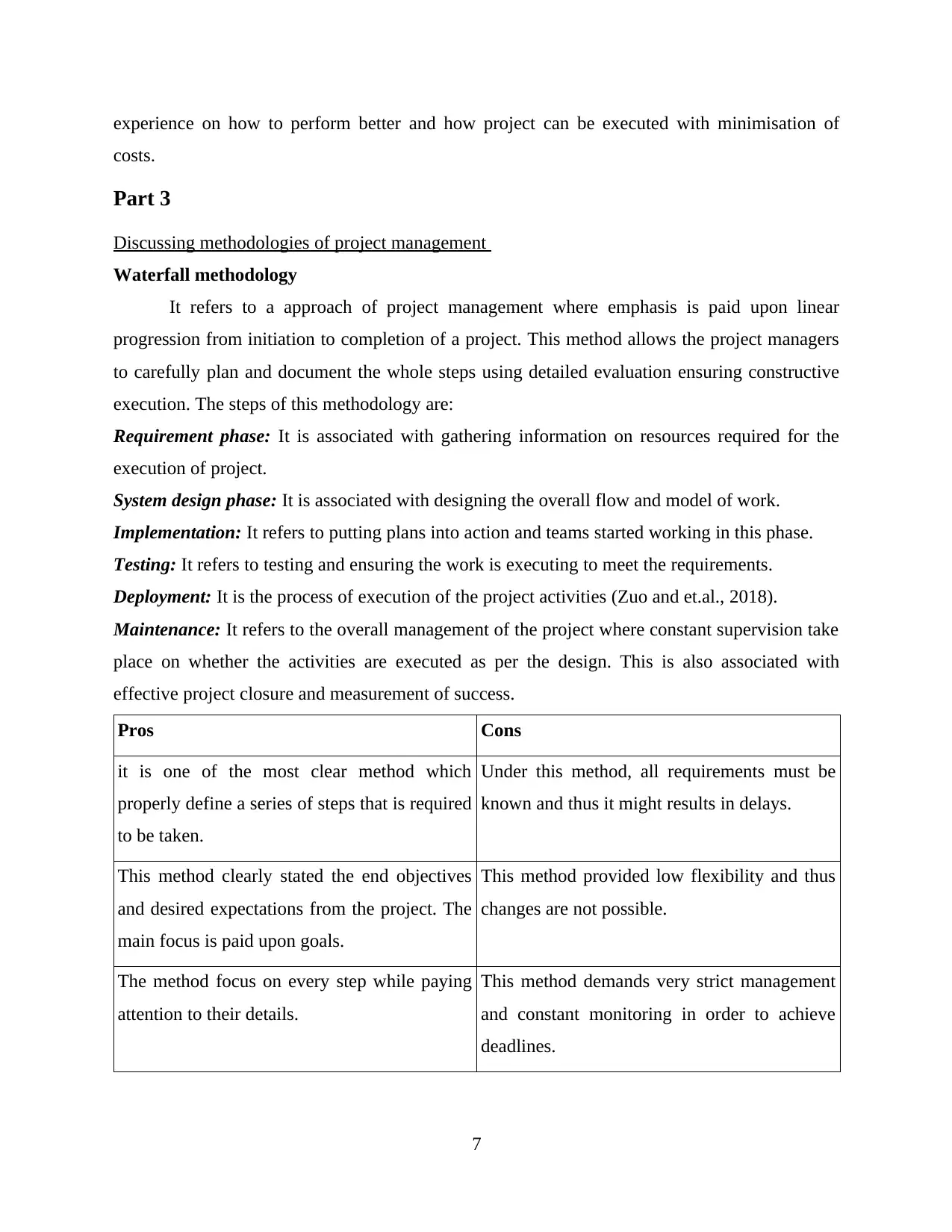
experience on how to perform better and how project can be executed with minimisation of
costs.
Part 3
Discussing methodologies of project management
Waterfall methodology
It refers to a approach of project management where emphasis is paid upon linear
progression from initiation to completion of a project. This method allows the project managers
to carefully plan and document the whole steps using detailed evaluation ensuring constructive
execution. The steps of this methodology are:
Requirement phase: It is associated with gathering information on resources required for the
execution of project.
System design phase: It is associated with designing the overall flow and model of work.
Implementation: It refers to putting plans into action and teams started working in this phase.
Testing: It refers to testing and ensuring the work is executing to meet the requirements.
Deployment: It is the process of execution of the project activities (Zuo and et.al., 2018).
Maintenance: It refers to the overall management of the project where constant supervision take
place on whether the activities are executed as per the design. This is also associated with
effective project closure and measurement of success.
Pros Cons
it is one of the most clear method which
properly define a series of steps that is required
to be taken.
Under this method, all requirements must be
known and thus it might results in delays.
This method clearly stated the end objectives
and desired expectations from the project. The
main focus is paid upon goals.
This method provided low flexibility and thus
changes are not possible.
The method focus on every step while paying
attention to their details.
This method demands very strict management
and constant monitoring in order to achieve
deadlines.
7
costs.
Part 3
Discussing methodologies of project management
Waterfall methodology
It refers to a approach of project management where emphasis is paid upon linear
progression from initiation to completion of a project. This method allows the project managers
to carefully plan and document the whole steps using detailed evaluation ensuring constructive
execution. The steps of this methodology are:
Requirement phase: It is associated with gathering information on resources required for the
execution of project.
System design phase: It is associated with designing the overall flow and model of work.
Implementation: It refers to putting plans into action and teams started working in this phase.
Testing: It refers to testing and ensuring the work is executing to meet the requirements.
Deployment: It is the process of execution of the project activities (Zuo and et.al., 2018).
Maintenance: It refers to the overall management of the project where constant supervision take
place on whether the activities are executed as per the design. This is also associated with
effective project closure and measurement of success.
Pros Cons
it is one of the most clear method which
properly define a series of steps that is required
to be taken.
Under this method, all requirements must be
known and thus it might results in delays.
This method clearly stated the end objectives
and desired expectations from the project. The
main focus is paid upon goals.
This method provided low flexibility and thus
changes are not possible.
The method focus on every step while paying
attention to their details.
This method demands very strict management
and constant monitoring in order to achieve
deadlines.
7
Paraphrase This Document
Need a fresh take? Get an instant paraphrase of this document with our AI Paraphraser
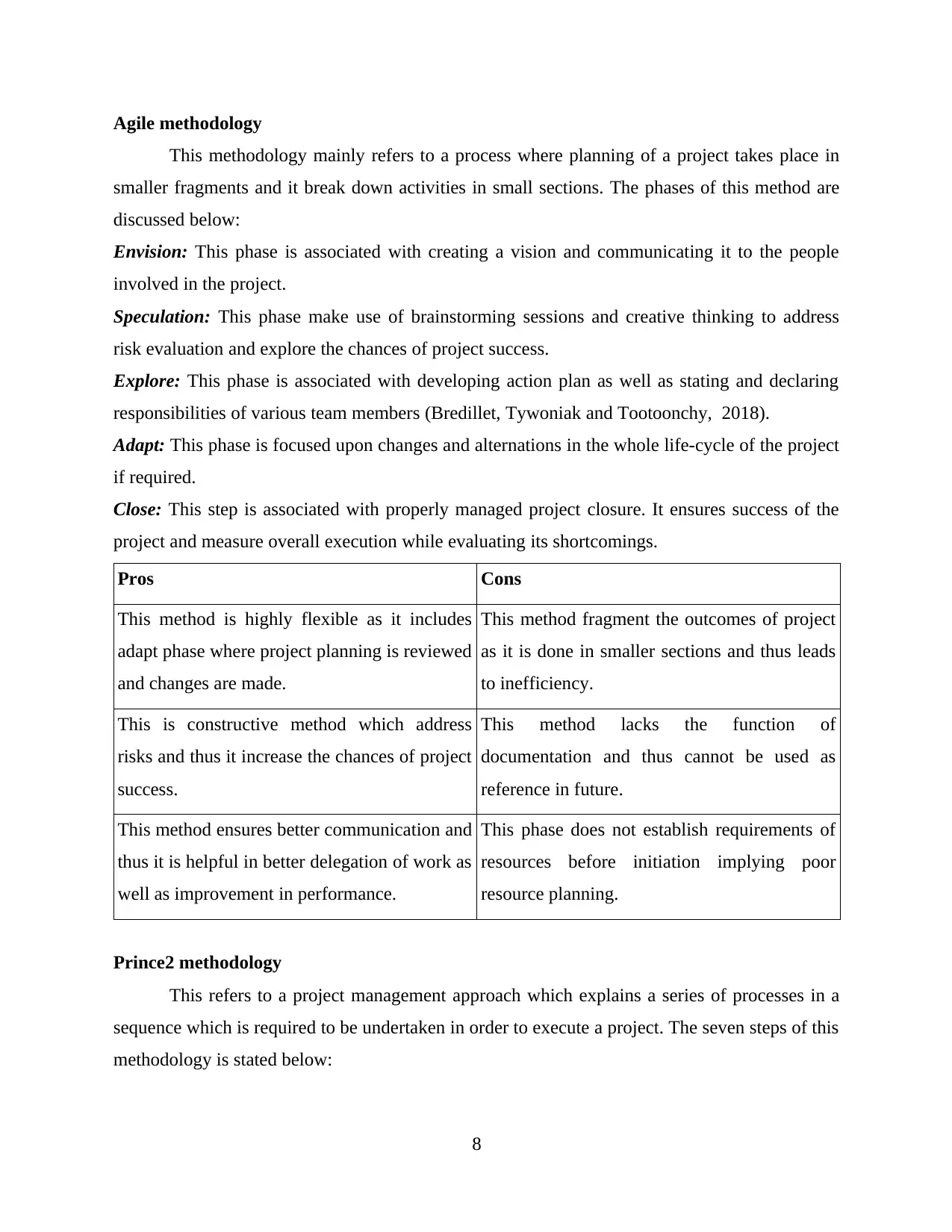
Agile methodology
This methodology mainly refers to a process where planning of a project takes place in
smaller fragments and it break down activities in small sections. The phases of this method are
discussed below:
Envision: This phase is associated with creating a vision and communicating it to the people
involved in the project.
Speculation: This phase make use of brainstorming sessions and creative thinking to address
risk evaluation and explore the chances of project success.
Explore: This phase is associated with developing action plan as well as stating and declaring
responsibilities of various team members (Bredillet, Tywoniak and Tootoonchy, 2018).
Adapt: This phase is focused upon changes and alternations in the whole life-cycle of the project
if required.
Close: This step is associated with properly managed project closure. It ensures success of the
project and measure overall execution while evaluating its shortcomings.
Pros Cons
This method is highly flexible as it includes
adapt phase where project planning is reviewed
and changes are made.
This method fragment the outcomes of project
as it is done in smaller sections and thus leads
to inefficiency.
This is constructive method which address
risks and thus it increase the chances of project
success.
This method lacks the function of
documentation and thus cannot be used as
reference in future.
This method ensures better communication and
thus it is helpful in better delegation of work as
well as improvement in performance.
This phase does not establish requirements of
resources before initiation implying poor
resource planning.
Prince2 methodology
This refers to a project management approach which explains a series of processes in a
sequence which is required to be undertaken in order to execute a project. The seven steps of this
methodology is stated below:
8
This methodology mainly refers to a process where planning of a project takes place in
smaller fragments and it break down activities in small sections. The phases of this method are
discussed below:
Envision: This phase is associated with creating a vision and communicating it to the people
involved in the project.
Speculation: This phase make use of brainstorming sessions and creative thinking to address
risk evaluation and explore the chances of project success.
Explore: This phase is associated with developing action plan as well as stating and declaring
responsibilities of various team members (Bredillet, Tywoniak and Tootoonchy, 2018).
Adapt: This phase is focused upon changes and alternations in the whole life-cycle of the project
if required.
Close: This step is associated with properly managed project closure. It ensures success of the
project and measure overall execution while evaluating its shortcomings.
Pros Cons
This method is highly flexible as it includes
adapt phase where project planning is reviewed
and changes are made.
This method fragment the outcomes of project
as it is done in smaller sections and thus leads
to inefficiency.
This is constructive method which address
risks and thus it increase the chances of project
success.
This method lacks the function of
documentation and thus cannot be used as
reference in future.
This method ensures better communication and
thus it is helpful in better delegation of work as
well as improvement in performance.
This phase does not establish requirements of
resources before initiation implying poor
resource planning.
Prince2 methodology
This refers to a project management approach which explains a series of processes in a
sequence which is required to be undertaken in order to execute a project. The seven steps of this
methodology is stated below:
8

Starting up a project: This stage is associated with deciding whether the organisation can afford
the a new project after evaluating it (Zwikael and Smyrk, 2019).
Directing the project: It is associated with determining viability and feasibility of the project and
is assigned to a project manager.
Initiation of project: This stage refers to a plan defining various parameters such as budget,
time, importance, benefits, scope etc.
Stage control: Under this step, teams are created and work is divided into various stages which
is reviewed by project manager.
Delivery management: Under this stage, it is ensured that there is no gap between standards and
deliverables (Ajam, 2018).
Managing stage boundaries: At this stage, the manager is responsible for reviewing and
measuring the outcomes of stages to make sure project would be executed properly.
Project closure: This stage marks the wind-up of the process including documentation and
reporting.
Pros Cons
It is highly flexible method which provide
scope for changes.
The method is integrated with massive
amounts of documentation.
It promotes effective communication and more
accountability.
This method requires constant reviewing and
updation of documents.
It is highly focused upon outputs and thus
ensures continuous improvement.
It implies less involvement of project manager.
Conclusion
After analysing the above methodologies, it has been concluded that waterfall
methodology is the most appropriate and suitable approach for the project management of
sporting event. Waterfall methodology is highly suggested and most significant approach for
this purpose as it ensures clarity of roles and requirements within the whole process of project
management. It access all the requirements before initiation of the project and thus is highly
effective in constructive execution. Moreover it ensures strict management and is less flexible
and organisation of sports events is a executed at large scale, hence very minimal changes is
9
the a new project after evaluating it (Zwikael and Smyrk, 2019).
Directing the project: It is associated with determining viability and feasibility of the project and
is assigned to a project manager.
Initiation of project: This stage refers to a plan defining various parameters such as budget,
time, importance, benefits, scope etc.
Stage control: Under this step, teams are created and work is divided into various stages which
is reviewed by project manager.
Delivery management: Under this stage, it is ensured that there is no gap between standards and
deliverables (Ajam, 2018).
Managing stage boundaries: At this stage, the manager is responsible for reviewing and
measuring the outcomes of stages to make sure project would be executed properly.
Project closure: This stage marks the wind-up of the process including documentation and
reporting.
Pros Cons
It is highly flexible method which provide
scope for changes.
The method is integrated with massive
amounts of documentation.
It promotes effective communication and more
accountability.
This method requires constant reviewing and
updation of documents.
It is highly focused upon outputs and thus
ensures continuous improvement.
It implies less involvement of project manager.
Conclusion
After analysing the above methodologies, it has been concluded that waterfall
methodology is the most appropriate and suitable approach for the project management of
sporting event. Waterfall methodology is highly suggested and most significant approach for
this purpose as it ensures clarity of roles and requirements within the whole process of project
management. It access all the requirements before initiation of the project and thus is highly
effective in constructive execution. Moreover it ensures strict management and is less flexible
and organisation of sports events is a executed at large scale, hence very minimal changes is
9
⊘ This is a preview!⊘
Do you want full access?
Subscribe today to unlock all pages.

Trusted by 1+ million students worldwide

preferred in such projects. This is the most crucial approach ensuring success and proper
implementation of activities of project.
10
implementation of activities of project.
10
Paraphrase This Document
Need a fresh take? Get an instant paraphrase of this document with our AI Paraphraser

References
Hair, J.F. and Sarstedt, M., 2021. Explanation plus prediction—The logical focus of project
management research. Project Management Journal, 52(4), pp.319-322.
Picciotto, R., 2020. Towards a ‘New Project Management’movement? An international
development perspective. International Journal of Project Management, 38(8), pp.474-485.
Bjorvatn, T. and Wald, A., 2018. Project complexity and team-level absorptive capacity as
drivers of project management performance. International Journal of Project Management, 36(6),
pp.876-888.
Kerzner, H., 2022. Project management case studies. John Wiley & Sons.
Obradović, V., Todorović, M. and Bushuyev, S., 2018, September. Sustainability and agility in
project management: contradictory or complementary?. In Conference on Computer Science and
Information Technologies (pp. 522-532). Springer, Cham.
Zuo, J. and et.al., 2018. Soft skills of construction project management professionals and project
success factors: A structural equation model. Engineering, Construction and Architectural
Management.
Bredillet, C., Tywoniak, S. and Tootoonchy, M., 2018. Why and how do project management
offices change? A structural analysis approach. International Journal of Project
Management, 36(5), pp.744-761.
Zwikael, O. and Smyrk, J.R., 2019. Project management: A benefit realisation approach.
Springer.
Ajam, M.A., 2018. Project management beyond waterfall and agile. Auerbach Publications.
Ismail, M.F.B. and Mansor, Z., 2018. Agile Project Management: Review, Challenges and Open
Issues. Advanced Science Letters, 24(7), pp.5216-5219.
11
Hair, J.F. and Sarstedt, M., 2021. Explanation plus prediction—The logical focus of project
management research. Project Management Journal, 52(4), pp.319-322.
Picciotto, R., 2020. Towards a ‘New Project Management’movement? An international
development perspective. International Journal of Project Management, 38(8), pp.474-485.
Bjorvatn, T. and Wald, A., 2018. Project complexity and team-level absorptive capacity as
drivers of project management performance. International Journal of Project Management, 36(6),
pp.876-888.
Kerzner, H., 2022. Project management case studies. John Wiley & Sons.
Obradović, V., Todorović, M. and Bushuyev, S., 2018, September. Sustainability and agility in
project management: contradictory or complementary?. In Conference on Computer Science and
Information Technologies (pp. 522-532). Springer, Cham.
Zuo, J. and et.al., 2018. Soft skills of construction project management professionals and project
success factors: A structural equation model. Engineering, Construction and Architectural
Management.
Bredillet, C., Tywoniak, S. and Tootoonchy, M., 2018. Why and how do project management
offices change? A structural analysis approach. International Journal of Project
Management, 36(5), pp.744-761.
Zwikael, O. and Smyrk, J.R., 2019. Project management: A benefit realisation approach.
Springer.
Ajam, M.A., 2018. Project management beyond waterfall and agile. Auerbach Publications.
Ismail, M.F.B. and Mansor, Z., 2018. Agile Project Management: Review, Challenges and Open
Issues. Advanced Science Letters, 24(7), pp.5216-5219.
11
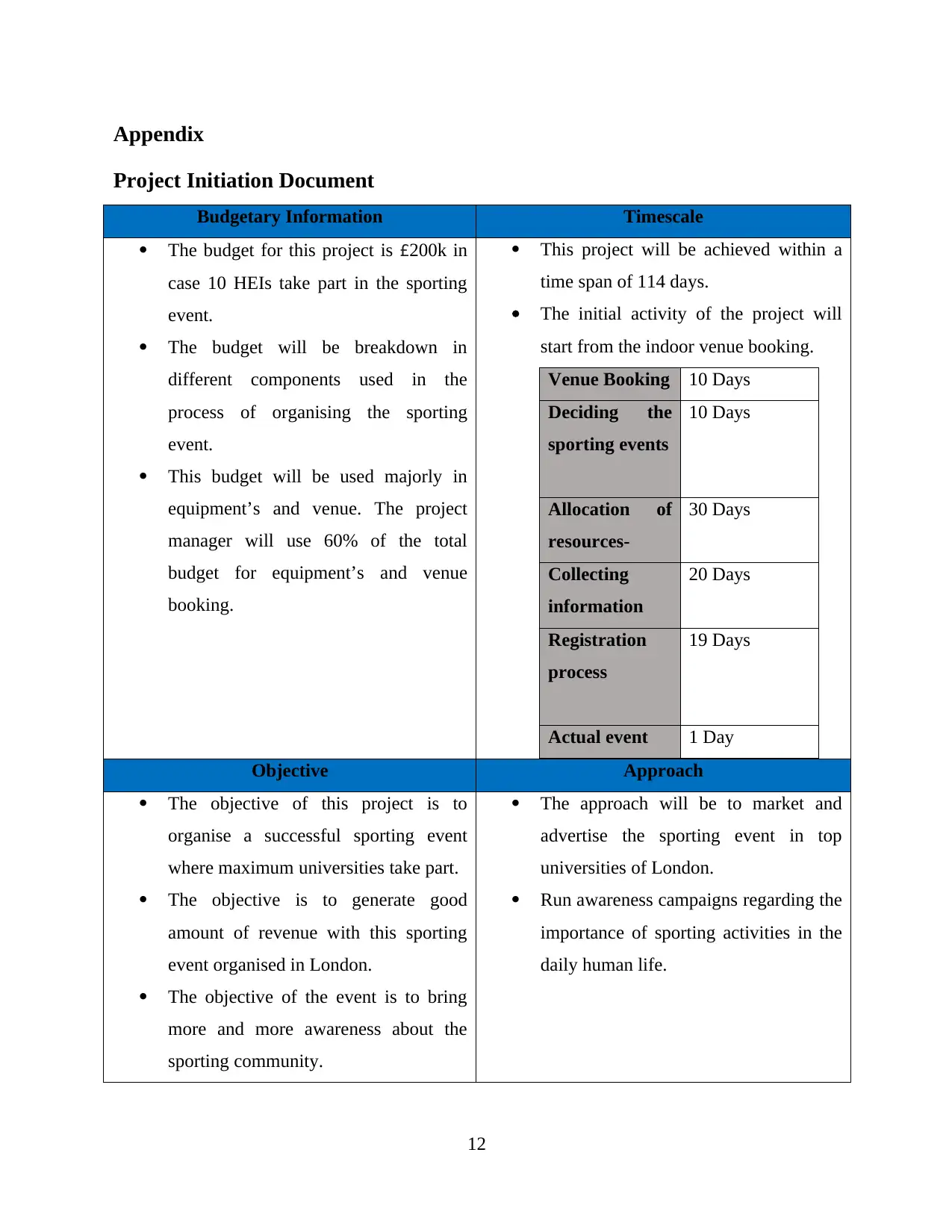
Appendix
Project Initiation Document
Budgetary Information Timescale
The budget for this project is £200k in
case 10 HEIs take part in the sporting
event.
The budget will be breakdown in
different components used in the
process of organising the sporting
event.
This budget will be used majorly in
equipment’s and venue. The project
manager will use 60% of the total
budget for equipment’s and venue
booking.
This project will be achieved within a
time span of 114 days.
The initial activity of the project will
start from the indoor venue booking.
Venue Booking 10 Days
Deciding the
sporting events
10 Days
Allocation of
resources-
30 Days
Collecting
information
20 Days
Registration
process
19 Days
Actual event 1 Day
Objective Approach
The objective of this project is to
organise a successful sporting event
where maximum universities take part.
The objective is to generate good
amount of revenue with this sporting
event organised in London.
The objective of the event is to bring
more and more awareness about the
sporting community.
The approach will be to market and
advertise the sporting event in top
universities of London.
Run awareness campaigns regarding the
importance of sporting activities in the
daily human life.
12
Project Initiation Document
Budgetary Information Timescale
The budget for this project is £200k in
case 10 HEIs take part in the sporting
event.
The budget will be breakdown in
different components used in the
process of organising the sporting
event.
This budget will be used majorly in
equipment’s and venue. The project
manager will use 60% of the total
budget for equipment’s and venue
booking.
This project will be achieved within a
time span of 114 days.
The initial activity of the project will
start from the indoor venue booking.
Venue Booking 10 Days
Deciding the
sporting events
10 Days
Allocation of
resources-
30 Days
Collecting
information
20 Days
Registration
process
19 Days
Actual event 1 Day
Objective Approach
The objective of this project is to
organise a successful sporting event
where maximum universities take part.
The objective is to generate good
amount of revenue with this sporting
event organised in London.
The objective of the event is to bring
more and more awareness about the
sporting community.
The approach will be to market and
advertise the sporting event in top
universities of London.
Run awareness campaigns regarding the
importance of sporting activities in the
daily human life.
12
⊘ This is a preview!⊘
Do you want full access?
Subscribe today to unlock all pages.

Trusted by 1+ million students worldwide
1 out of 15
Related Documents
Your All-in-One AI-Powered Toolkit for Academic Success.
+13062052269
info@desklib.com
Available 24*7 on WhatsApp / Email
![[object Object]](/_next/static/media/star-bottom.7253800d.svg)
Unlock your academic potential
Copyright © 2020–2025 A2Z Services. All Rights Reserved. Developed and managed by ZUCOL.




